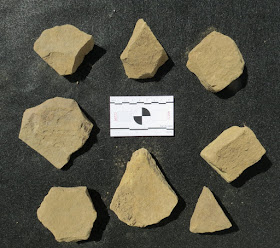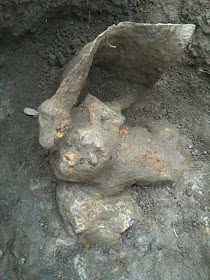Subjectivity in Stone Age art works such as figure stones, engravings, sculptures, effigies and curated manuports. See how images and icons have been realized in portable rock media since the dawn of humanity. Here, archaeologists and art historians are becoming aware of these forsaken artifacts. “And this our life, exempt from public haunt, finds tongues in trees, books in the running brooks, sermons in stones, and good in every thing." -in W. Shakespeare, As You Like It, 1599.
Denisovan Ancestry in East Eurasian and Native American Populations
▼
29 August 2016
Etched piece of lime hornfels from Fairfax County, Virginia
Etched piece of hornfels - possible "portable rock art" recovered from a site in Fairfax County, Virginia in 2006.
21 August 2016
Landscapers inadvertently return probable large mammoth sculpture to its original upright position
 Ken Johnston Paleolithic art mammoth sculpture find, Licking County, Ohio |
'Mammoth left profile'
Side 1
Side 2
Side 1 from front

Side 2 from front
The stone is a flake off a large boulder. Its perimeter has been shaped to sculpt the profile of the body of a mammoth. A complete petrological examination will confirm this as a humanly-shaped portable rock art sculpture.
Modern day landscapers were attracted to this stone because of its thinness and ability to stand upright on a flat base. They encountered this stone when restoring a garden and decided to make it a part of the visual interest of a stream confluence construction. There is a boulder next to the mammoth sculpture but it is not propping up the mammoth stone and does not appear related to it.
This view favors the posterior of the mammoth sculpture
Faint trace of a possible zooanthropomorphic right facial profile on the posterior of the mammoth sculpture is in line with other examples from this place like seen in the last posting. There is possible evidence of some focused grinding to create an 'eye divot' seen as a whitish spot.
This stone presents a striking mammoth likeness which I propose was cultivated in the Ice Age and left for landscapers to discover and then prop up this year. It makes an ideal "standing stone." I was able to recognize it as a potentially significant portable rock art sculpture. The context here is strong, directly on the maximum geographic extent of the Wisconsinan glaciation. I have found other mammoth figures here as well as innumerable coarse stone tools.
Prior posting mammoth and human combination sculpture found just a few hundred yards from the probable mammoth sculpture featured here.
Human facial profile with mammoth head cresting forehead from this site
Human facial profile with mammoth head cresting forehead from this site. This is the only piece of Flint Ridge flint I have found on this 1,000+ acre site despite its being located just 5 miles from this famous chert quarry location.
Sample of the coarse stone tools which are found by the thousands at this site
This boulder with a natural right edge approximating the curvature of a mammoth trunk was featured earlier on this blog. It was found just two miles from the mammoth in this posting and in the same watershed. It has a crude sculpted face on its posterior which supports the proposition of boulder-size mammoth sculptures in this locality.
17 August 2016
An Ohio sculpture in the 'Mammoth profile with human face profile on its posterior' Paleolithic art motif may have relation to Russia example
Ken Johnston find, Licking County, Ohio
This sculpture was found in soil disturbed for landscaping purposes and within 50 yards of a few other mammoth and human combination sculptures which have been featured on this blog. It was found directly on the advancement line of the Wisconsin glaciation and terminal moraines are visible from the find location of this sculpture.
The sculpture stands upright on a flat base which has been created by grinding
A rock patina created by human fingers contact while the base was ground flat
This mammoth figure from the Avdeevo, Russia, archaeology site was featured in Bahn and Lister's book Mammoths: Giants of the Ice Age. The mammoth is facing left and I interpret a faint but present icon of a human face on the posterior of the mammoth in right 3/4 profile. Dates given for Avdeevo are 22 800 ± 160, 23 140 ± 430, and 23 400 ± 700. Adam Arkfeld noted a similarity of this artifact to mammoth sculptures from his Clear Brook, Virginia, archaeology site.
I propose the motif seen in both the Ohio and Russia examples implies some kind of cultural or traditional relatedness spanning at least 4,600 miles.
15 August 2016
Another amateur archaeologist dismissed by The Cleveland Museum of Natural History "knows better"
'Human head left profile in translucent stone material'
Christian Kotze finds of Lake County, Ohio. These Ohio finds have been discounted by the archaeology curator at Cleveland Museum of Natural History as natural despite his having no knowledge about portable rock art.
Side two is a human head right profile worked in the same detail. Yes, good ole' Mother Nature putting delicately detailed human faces on two sides of a remarkable cryptocrystalline rock specimen. It appears to be carnelian agate which has been seen in other portable rock art pieces on this blog, but only from the state of Oregon.
A beautifully sculpted human head left 3/4 profile in typical portable rock art form where the artist is exploiting the natural shape and properties of the stone by working it to tease out the desired visual properties. Click photos to enlarge.
Because North American archaeologists have never been educated about it and don't operate like real scientists, they are unable to see these objects as anything but natural rocks. They have never taken the time to have these objects examined by petrologists because they are so certain human crafted objects like this do not exist.
Its time they stop wasting all these archaeological heritage cultural resources by telling people they are just rocks when they have no business making such executive determinations from ignorant positions of authority.
Christian writes, "This piece I found in Trumble County more than 30 years ago. I always have thought it resembled a horse. On what appears to be the mane it has serrated edges."
The source of the stone material here appears to Flint Ridge, Ohio, which is about 120 miles from the location where Christian found it.
Some have thought zoomorphic shapes like this may be animal representations with a built-in handle to hold the figure like a 'stone puppet.' To me, the first side may depict a feline head and the opposite side of the stone may depict a human.
Possible human head representation on the puppet-like stone
Christian identified an anthropomorphic head profile on the left edge of this stone, among many, many others. These simple forms are sometimes faint, faded and worn and may have been much more visible to an observer in the Stone Age. I think this piece is symbolic of a mammoth body profile facing right with a human facial profile incorporated onto its posterior in a well documented motif seen on this blog.
"Here is a piece I found near Willoughby, Ohio. It is made of brown and grey chert. The left side depicts a mans face, it fits into the right hand comfortably. The top is a scraper."
Dear Mr. Johnston, my name is Christian Kotze. I live in Mentor Ohio (Lake Co.) I have a large collection of artifacts that contain effigies on them some of animals others of humans. From what I have seen on your site I believe mine are more defined some are perfect and there are multiple pieces that are the same.
I have talked to people associated with the museum some who appeared to be amazed and took pieces with them to show Dr. Brian Redmond who discounted them as natural but I know better. I have been studying these for a long time and used special lights, microscopes and other tools. These pieces are from all over the state. I would like to show them to others who might also have similar art in their collection.
-Christian Kotze, Mentor, Ohio
09 August 2016
Stark County, Ohio, landowner and amateur archaeologist is blown off by a supposed expert but confirms his independent observations by finding bone and wood evidence of human activity
'Flaked chert human head likeness, facing left'
Adam Robinson finds, unglaciated portion of Stark County, Ohio
Adam's site is on a promontory hilltop locally known as "The Top of the World"
Human head profile, facing left
'Duck with workbench on its back'
I interpret this object as a 'duck form anvil.' The artist has taken advantage of the natural form of this concretion to craft an anvil or workbench with a duck head facing left on the upper left of the stone seen here. It is as if the duck has the anvil work surface on its back. This piece may have been used to process red ocher as evidenced by the red staining on the anvil surface.
Duck form workbenches have been described by independent portable rock art researcher Jan van Es of the Netherlands and several North American examples in line with his "Old World" observations have been featured on this blog.
Illustration of the interpreted elements of this combination of a sculpture and a functional tool.
This appears to be fossilized spirally fractured bone which would suggest a human presence at Adam's hilltop site.
Adam uncovered this cluster of objects and has reburied it and left it mostly in situ for professional archaeological recovery. There is a crudely pounded kind of sheet metal and a crude metal rod. I detected a human or animal face on what appears to be an animal figure fused to the stone below it. I think the animal may be made of metal as well based on its patina compared to the sheet metal.
Adam Robinson writes, "I've spoken to Brian Redmond at the museum (Cleveland Museum of Natural History) a few times and sent photos. He blew me off and basically told me I had a pile of rocks."
Due to extraordinary preservation conditions of a dry clay environment, Adam Robinson recovered a 'club' consisting of a rock nested in its original wooden handle. Adam's 'pile of rocks' may indeed be more than it seems to those like Dr. Redmond.
This piece of wood presents a significant opportunity to obtain a radio carbon date associated with this kind of yet-undescribed composite tool form and perhaps then the art Adam has identified. The Cleveland Museum and others like it remain incompetent to do the good work of Archaeology. Amateurs are capable of significant contributions to archaeology knowledge but have limited controls, resources and access to labs.
Archaeology continues to disadvantage itself by habitually marginalizing the observations of amateurs and independent researchers.
Stark County, Ohio, compound wood and stone club could contain significant information if a proper scientific examination were made.
Adam has found a second compound tool involving stone forms which have never been recognized by Archaeology as anything other than "just rocks." This one is an ax.
Adam Robinson confirms the observations of many others that apparently worked or utilized crude stones like this they find in concentrations are cultural material, contrary to the findings of North American Archaeology and its 100+ years of "work."















































